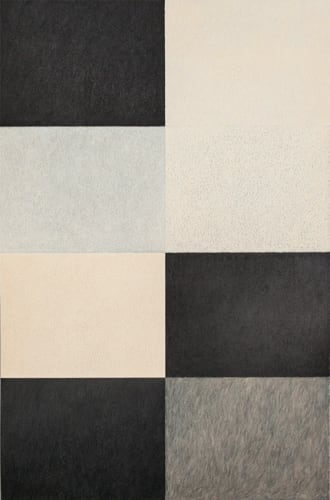To see “Ghost: Rhythms,” Chicago-based artist McArthur Binion’s first solo exhibition at Kavi Gupta, was to be let in on a secret. From a distance, the rarely seen abstractions on unstretched canvas and aluminum from the artist’s early career in New York during the 1970s recall aerial maps or stratified rock formations. Upon closer inspection, the seemingly monochromatic beige oil-stick skeins give way to teeming beds or imperfect grids of barely perceptible crisscrossing blue, green, and red lines. By insisting that viewers look not only at but through his subtle, multilayered works, Binion invites an excavational mode of seeing attuned to the ghosting of mark-making itself- a major theme of the artist’s oeuvre as a whole.
While the artist’s biography often overshadows more formal analyses of his work, it would be difficult to deny the significance of Binion’s past when considering his practice. Following his childhood in rural Mississippi, where he picked cotton at a young age, and in Detroit, where his family worked the assembly lines of the automobile industry, Binion became the first African American to obtain an MFA from the Cranbrook Academy of Art in Bloomfield Hills, Michigan. Inspired by the scale and materiality of Abstract Expressionism and Minimalism, he developed a pared-down visual language to engage the legacy of painting. Though his work, which was well regarded during the ‘70s, faded into obscurity soon thereafter, Binion has recently reemerged in the public eye. (His first solo institutional exhibition, for example, took place at the Contemporary Arts Museum Houston in 2012.)
Binion’s paintings are archives of moments of contact and adhesion- records of the artist’s regulated method of grinding Dixon wax crayon onto canvas or aluminum. The effect, in his monochromatic works of this type, is reminiscent of that of Jasper Johns’s encaustic White Flag, 1955, and the younger artist’s paintings have been read as an inhabitation of modernist forms with monotonous task-based operations that bespeak Binion’s personal history of manual labor. The early pieces on view, several of which were included by Ronald Bladen in a 1973 exhibition at Artists Space organized with Sol LeWitt and Carl Andre, bear the marks of this characteristic process, which Binion still uses today.
Exemplifying just the type of imperfect correlations that structure Binion’s work, the title of one painting, Icecicle: Juice, 1976, analogizes ice (water’s solid form) and juice (a liquid squeezed from a solid object). Accordingly, the painting’s eight checkerboard segments seem to chart different states of matter, ranging from thickly applied, impenetrable black crayon to pale, amoeba-like wax sitting atop a dark ground . Arranged in an orderly grid, yet each distinctly composed by Binion’s varied applications of pressure, the segments enact a kind of homology fitting for the title’s inexact comparison.
Installed in a separate viewing room with more recent works, Rudebega: No: The Sky, 1978-79, high lights the material effects of his process: Protrusions of bright red and orange wedges of wax are so thick that the smell of crayon still lingered. Like the individuation of each fingerprint-size mark, the title’s unlikely analogy similarly complicates the idea of a one-to-one equivalence. In the titles of these and the other works on display, Binion instrumentalizes the colon symbol as a passageway that embodies a logic of correspondence, thus pointing to the paradoxical structures underlying his work: Binion’s fusion of artistic gesture and iterative labor, equivalence and difference, aligns his practice with that of post-Minimal and Conceptual artists, but the intimacy of his surfaces’ construction, their unfolding into multiple levels of trace and duration, gives the paintings a haunted sense of historical revisitation.
